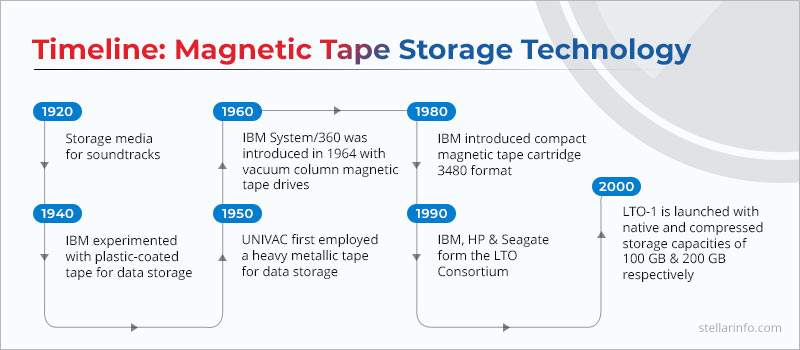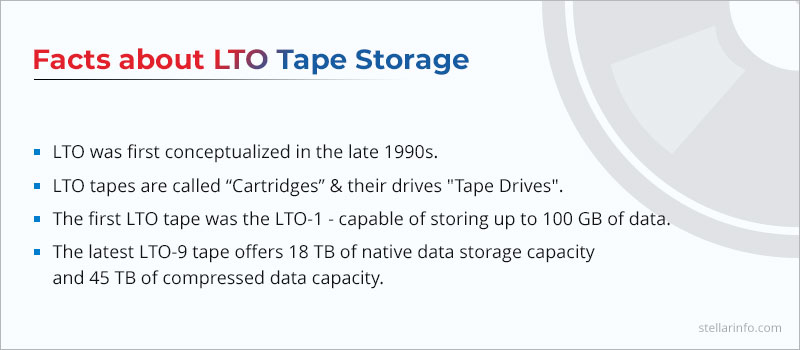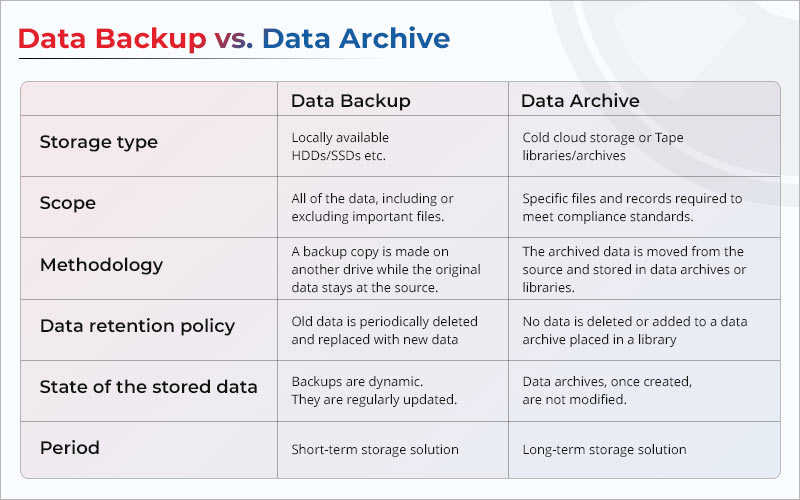Magnetic tapes have seen a resurgence in recent times. Thanks to the giant leaps in storage capacities, LTO magnetic tape technology has become a reliable medium for storing large data sets. From floppy diskettes to cutting-edge QLC NAND drives, individual data storage technology has jumped light years ahead.
For an average consumer, magnetic tape storage is a thing of the past. Their towering collection of cassettes and VHS tapes was lost in the sands of time amidst the rapid development of sophisticated and compact storage media.

While most of us remember tapes as cassettes and VHS tapes, another industrial application of magnetic tapes has recently seen a surge. We are talking about enterprise-level data archival and backup technology – LTO or Linear Tape Open technology. Large-scale enterprises that deal with data storage and archiving have been increasingly using tape drives and magnetic tapes to meet their dynamic storage needs.
Unlike mass-market storage media like HDDs and SSDs that are inclined towards individual or small-scale enterprises, magnetic tapes cater to large corporations dealing with colossal amounts of data. They offer massive storage capability for thousands of data archives and libraries.
Large-scale enterprises that deal with data storage and archiving have been increasingly using tape drives and magnetic tapes to meet their dynamic storage needs.
While HDDs and SSDs are faster and easy to use, they have a significantly shorter life span of 3-5 years. Further, their limited storage capacity can become a hurdle when you need to store copious amounts of data. Hence, conventional storage media has mainly become unsuitable for large-scale enterprises that need to keep huge, long-term data archives.
To overcome this challenge, LTO tape drive technology came to the forefront. LTO has surpassed not only conventional storage media but also pre-LTO era tape drive technologies, such as AIT, DLT, DAT, etc., in terms of reliability, operational costs, and storage capacities.
Magnetic Tape Storage Technology – A Brief History
Magnetic tape drives are one of the earliest data storage media that are still relevant. In the 1920s, it was developed as a medium to record sound. By the 1950s, its usage expanded to storing video as well. By the late 1990s, the digital revolution led to the development of advanced magnetic tapes for data storage and retention. This advanced magnetic tape storage technology was named LTO. LTO, or Linear Tape Open, is a long-term data storage technology initially developed as an open standards alternative to the magnetic tape formats hidden behind trademarks and registered patents.

What is an LTO Storage Tape?
Linear Tape Open or LTO Ultrium format is a highly scalable, powerful, reliable, and flexible magnetic tape storage solution optimized for large and ultra-large-scale enterprises handling enormous amounts of data.

Facts about LTO Tape Storage
- LTO, or Linear Tape Open Ultrium technology, was first conceived in the late 1990s.
- LTO tapes are offered as “Cartridges” containing hundreds of meters of magnetic tape.
- The first LTO tape was the LTO-1, which was could store up to 100 GB of data.
- The latest LTO-9 tape offers a staggering 18 TB of native data storage capacity and 45 TB of compressed data capacity.

An LTO tape contains a reel of magnetic tape running hundreds of meters in length. These tapes are mainly used to archive data for a longer duration. An LTO tape is offered as a cartridge inserted in LTO Ultrium tape drives.
LTO tapes are mainly used by enterprises where they create large physical areas called libraries to hold an extensive number of cartridges and tape drives.
Magnetic Tape Backup vs. Archive: What’s the Difference?
Magnetic tapes are an ideal data storage solution for archiving colossal amounts of data for extended periods. Traditional storage media like HDDs, SSDs, or hot cloud platforms are faster but are not preferred for data archiving because of their limited lifespan and dynamic nature.
For an average user, data backups and data archives are similar. However, technically, they are quite different. Here is a brief distinction between the two processes.

Advantages of Using Magnetic Tape as an Archive Storage
Libraries, data archives, and large enterprises – they all have a goal to retain large amounts of data for extended periods of time (15+ years). This is why magnetic tape drives are used for their numerous advantages over conventional storage media. Some of these advantages are –
- Reliable over conventional storage drives
- Lowered cost of ownership
- Low power requirement
- The higher density allows more data to be stored per unit of space
- Scalable infrastructure
- Offers encryption and password protection for enhanced security
- Additional redundancy mechanisms simplify data recovery in case of damage or faults

Challenges While Using Tape Storage as an Archive
While there are a lot of advantages to using tape storage, there are also some challenges that enterprises and IT professionals face while using magnetic tapes. Some of the challenges and drawbacks of using magnetic tape storage are –
- Slower read/write speeds
- Requires sequential access, resulting in latency
- Requires special tape drives and libraries
- Limited portability and accessibility
- Requires planning a large-scale data retention & management policy
- Requires frequent tape monitoring to prevent overtime data degradation
- Tape storage failure due to stiction, mold, or acid formation caused by improper tape library infrastructure
Possibility of Data Recovery from a Magnetic Tape Cartridge
Retrieving data from LTO tapes becomes challenging as there are a lot of causes to consider. Some of the causes that affect tape data recovery are –
- Magnetic tape damage
- Unsupported file type of the backup
- Damaged/misaligned leader pin
- Mold/acid formation on the tape
- Magnetic tape layers sticking together due to the tape layers stuck together
- Incompatible drivers between the host and the tape library
- Hardware issues like malfunctioning tape drive, damaged signal cables, or RAID adapter
- Unknown tape backup format
These can make or break the possibility of recovering data from a magnetic tape. However, in some scenarios where the error is due to incompatible hardware or drivers, it is advised to use a magnetic tape data recovery software.
Such software packages allow users to create image dumps of tape drives and recover data from old tapes & tape image dumps. These software supports various tape data parsers, such as BKF, Tivoli, Symantec, Windows-NT, and more.
You can utilize such software to securely recover magnetic tape data. Therefore, any entity dealing with magnetic tape archives and large pools of data should have a tape data recovery solution installed in their environment at all times.
Conclusion
Magnetic tape storage – a technology of the past has seen giant resurgence in the recent days. These tape drives are now being used as large data archives and libraries to store and maintain records for longer periods.
In today’s data-driven world, magnetic tape storage archives are being employed extensively for their reliability, lower operational costs, and higher capacities per drive.
However, enterprises looking for long-term data storage do not prefer backing up a magnetic tape. In any situation, if there is a requirement for long-term, scalable data storage, tape storage archives are the way to go.
Related Reads













 9 min read
9 min read




